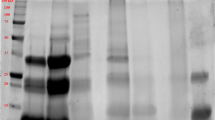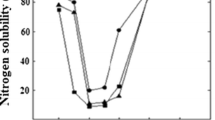Abstract
Soy protein concentrates were produced using direct aqueous membrane extraction from full-fat and defatted soy flours with a 100 kDa molecular weight cut-off ultrafiltration cartridge. The functional properties of soy protein concentrates were evaluated. Protein contents of membrane-processed soy protein concentrates from full-fat and defatted soy flour were 68.6 and 80.0%, respectively. Membrane-processed soy protein concentrates was lighter, more greenish, and less yellowish than acid-precipitated concentrates. Solubility, emulsification capacity and stability, and foaming capacity and stability of membrane-processed soy protein concentrates were significantly (p<0.05) greater than those for acid-precipitated concentrates. Amino acid profiles of both membrane-processed and acid-precipitated soy protein concentrates were comparable. Membrane processing using ultrafiltration can be used as a mild and chemical-free process to produce soy proteins from soybeans.
Similar content being viewed by others
References
van Vliet T, Martin AH, Bos MA. Gelation and interfacial behavior of vegetable proteins. Curr. Opin. Colloid In. 7: 462–468 (2002)
Pearson AM. Soy proteins. pp. 67–104. In: Developments in Food Engineering. Yano T, Matsuno R, Nakamura K (eds). Blackie Academic & Professional Publishing Co., London, UK (1994)
Utsumi S, Nakamura T, Harada K, Mori T. Structure-function relationships of soy proteins. pp. 257–291. In: Food Proteins and Their Applications. Damodaran S, Paraf A (eds). Marcel Dekker, New York, NY, USA (1997)
Endres JG. Soy Protein Products: Characteristics, Nutritional Aspects, and Utilization. AOCS Press, Champaign, IL, USA. pp. 4–8 (2001)
Nielson PM. Functionality of protein hydrolysates. Vol. V, pp. 443–472. In: New Protein Foods. Damodaran S, Paraf A (eds). Marcel Decker, New York, NY, USA (1997)
Rao A, Shallo HE, Ericson AP, Thomas RL. Characterization of soy protein concentrate produced by membrane ultrafiltration. J. Food Sci. 67: 1412–1418 (2002)
Krishna Kumar NS, Yea MK, Cheryan M. Soy protein concentrates by ultrafiltration. J. Food Sci. 68: 2278–2283 (2003)
Nichols DJ, Cheryan M. Production of soy isolates by ultrafiltration: Factors affecting yield and composition. J. Food Sci. 46: 367–372 (1981)
AACC. Approved Method of the AACC. 10th ed. Method 71-10. American Association of Cereal Chemists, St. Paul, MN, USA (2000)
AOAC. Official Methods of Analysis of AOAC Intl. 16th ed. Method 32.2. Association of Official Analytical Communities, Arlington,VA, USA (1995)
Knabe DA, Larue DC, Gregg EJ, Martinez GM, Tankley Jr. TD. Apparent digestibility of nitrogen and amino acids in protein feed stuffs by growing pigs. J. Anim. Sci. 67: 144–151 (1989)
Franzen KL, Kinsella JE. Functional properties of succinylated and acetylated soy protein. J. Agr. Food Chem. 24: 788–795 (1976)
Pearce KN, Kinsella JE. Emulsifying properties of proteins; Evaluation of a turbidimetric technique. J. Agr. Food Chem. 26: 716–723 (1978)
Volkert MA, Klein BP. Protein dispersibility and emulsion characteristics of four soy products. J. Food Sci. 44: 93–96 (1979)
Beery KE. Preparation of soy protein concentrate products and their application in food systems. pp. 62–65. In: Proceedings of the World Congress on Vegetable Protein Utilization in Human Foods and Animal Foodstuffs. Applewhite TH (ed). AOCS Press, Champaign, IL, USA (1989)
Vojdani F. Solubility. pp. 11–28. In: Methods of Testing Protein Functionality. Hall GM (ed). Blackie Academic & Professional Publishing Co., London, UK (1996)
Cheryan M. Ultrafiltration and Microfiltration Handbook. Technomic Publishing Co., Lancaster, PA, USA. pp. 120–135 (1998)
Arrese EL, Sorgentini DA, Wagner JR, Anon MC. Electrophoretic, solubility, and functional properties of commercial soy protein isolates. J. Agr. Food Chem. 39: 1029–1032 (1991)
Hill SE. Emulsions. pp. 153–163. In: Methods of Testing Protein Functionality. Hall GM (ed). Blackie Academic & Professional Publishing Co., London, UK (1996)
Molina E, Papadopoulou A, Ledward DA. Emulsifying properties of high pressure treated soy protein isolate and 7S and 11S globulins. Food Hydrocolloid. 15: 263–269 (2001)
Kinesella JE. Functional properties of soy proteins. J. Am. Oil Chem. Soc. 56: 242–258 (1979)
Damodaran S. Amino acids, peptides, and proteins. pp. 299–300. In: Fennema’s Food Chemistry. 4th ed. Damodaran S, Parkin KL, Fennema OR (eds). CRC Press, New York, NY, USA (2008)
Felipe P, Yang YH, Lee JH, Sok DE, Kim HC, Yoon WK, Kim HM, Kim MR. Effect of cultivars, cooking and processing on the trypsin inhibitor activity of soybean. J. Food Sci. Nutr. 10: 6–10 (2005)
KNS. Dietary Reference Intakes for Koreans. The Korean Nutrition Society, Seoul, Korea. p. 115 (2010)
Author information
Authors and Affiliations
Corresponding author
Rights and permissions
About this article
Cite this article
Kim, H.J., Kim, B.K. Comparison of soy protein concentrates produced using membrane ultrafiltration and acid precipitation. Food Sci Biotechnol 24, 67–73 (2015). https://doi.org/10.1007/s10068-015-0011-5
Received:
Revised:
Accepted:
Published:
Issue Date:
DOI: https://doi.org/10.1007/s10068-015-0011-5




